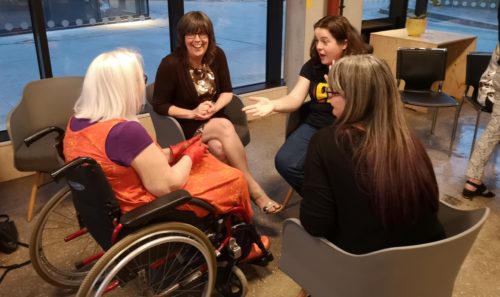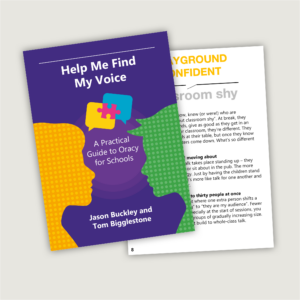Who this toolkit for
Our 12-principle oracy toolkit, explained below, is for anyone who wants to help young people find their voice. This will most probably mean you're a teacher, of any subject or any age or a member of SLT looking to generate whole-school change. But this toolkit is equally useful for youth group leaders or intervention specialists.
This toolkit presents 12 memorable principles to keep in mind when facilitating any kind of talk in your classroom. We've developed them over the last 15 years working week-in, week-out helping schools embed oracy, P4C and discussion into their topics.
We briefly explain each one below, but there's far more to each one - including explanation, activities and variations - that cannot be covered here. They're in our minibook "Help Me Find My Voice" available to buy in our shop today.
These ideas practical, tried, tested and trusted. We hope you find them useful.


Strategies to help every pupil:
The 12 Principles of our Oracy Framework
Hundreds of schools trust us to help improve listening, develop independent thinking and help every child find their voice.
All by showing teachers easier, more effective ways to work with their existing curriculum, not piling more on their plate. Each of these principles are detailed in our book - Help Me Find My Voice - and form the basis of our INSET.
1. Playground Confident, Classroom Shy
Think of children you know, knew (or were!) who are “playground confident but classroom shy”. At break, they tell jokes, boss their friends, give as good as they get in an argument. But inside your classroom, they’re different. They might talk to a few friends at their table, but once they know you’re listening, the shutters come down. What’s so different out on the playground? In the book, and in our training, we explore the ways you can bring that playground energy in without losing any control.
2. Small Talk Before Big Talk
When did you last have a meeting where the very first thing you spoke about was the subject of the meeting? Unless you are getting fired or firing someone, it almost never happens. A meeting without preliminary small talk lacks the human touch. Yet when we get children to work in groups, we don’t usually leave any space for that small talk to take place. We assume that they are primed and ready to talk about whatever we want them to talk about. In our book and through our training, we outline the most practical ways to get them talking about something, before they talk about something of consequence.
3. Sides Then Selves
We take pride in getting children to think for themselves, celebrating their diverse opinions rather than imposing a point of view on them. The first question we ask is often some variation of, “What do you think?” But perhaps that question should come later For a start, we may be asking about something entirely new to students. So an honest response to, “What do you think?” could be, “Not much. In fact I’ve never thought about this at all.” So let's get them thinking about what someone might say, before asking them to give what they think.
4. Stretch
Think of a time when you’ve held back from entering a conversation you wanted to join. Maybe you felt intimidated by the complexity of a topic, or your limited knowledge of it compared to others, and didn’t want to be shown up. That’s what we call, “stretch” – when a child is held back from speaking because their answer to, “How hard is it going to be to get this right?” is “Too hard for me!” We detail ways to avoid the cognitive side of speaking fear, whilst maintaining the challenge.
5. Exposure
Think of a time when you were anxious about speaking because there were so many people, or the people were so important, or the event was so special. That’s what we call, “exposure” – when a child holds back from speaking because their answer to, “How bad will it be if I get this wrong?” is “Too bad for me!” Exposure is the social side of speaking fear. So how can we counteract it? With cover.
6. Shrink
Have you ever seen young children “playing schools”? What’s the time of day they most often act out? Almost everyone says, “the register”. My nieces used to get home, line up their dolls and register them within an inch of their lives. The dolls never learned a thing, but they never bunked off. It’s the time of day when the status gap between teacher and child is at its greatest. But this teacher power can work against us, and crucially, them, if we want them to talk. So how can we lower our status without losing our power?
7. Serve and Return
The most recent work seems to support the view that yes, there’s not such a huge gap in the words children have heard if you include overheard conversations, but that what really counts is the quantity and quality of conversational turns a child has - and while there is a correlation with social class there are plenty of exceptions in both directions. The book, and the training, shows you practical ways to create easy back and forths between pairs.
8. Co-Coaching Questions
How can you push for depth in 15 conversations at once? The answer lies in co-coaching questions. These are questions that students can use to push one another’s thinking deeper.
9. Talk Three Times
This is the simplest of all the principles in the book. Instead of getting them to talk about three different questions, get them to talk about the same question three times.
This principle is especially important if you have a class with EAL learners. If possible, their first talk can be with someone who shares their first language.
10. Speaking Without Thinking
We’ve reached some tricky cases on the edges of who you can help without specialist intervention. Those children who at some point in their careers, have discovered a pair of magic words that stop teachers pestering them. “I dunno”. There is something quite unchallengeable about “I dunno”. It takes its strength from the bald truth that each of us has a mind of their own. You might know (and care about it) but I don’t. And you can’t make me know something. But the trump card up our sleeve is getting them to speak without having to think. And we'll show you how.
11. Unwrongification
We looked at the fear of getting things wrong in Stretch and how hedging can help to mitigate it. But there are two other ways to make children feel either that they can’t get it wrong, or that it doesn’t matter if they do.
12. PRACTICE over performance
This is the final principle, because it sums up the shift in mindset that is needed for optimal oracy.
Help Me Find My Voice
This practical guide to oracy explores why kids don’t talk in class – from kids who are “playground confident, classroom shy” to those who need to be someone else before they can be themselves. It’s fifteen years of experience of getting kids talking, boiled down to twelve principles you can use in every setting.
We hope this book arms you with the strategies you need to make one of the biggest differences you can – helping a child find their voice.

Fancy a chat about oracy training?
No obligation - just a chat about what might be possible!
Interested in training?
Contact us today to arrange a chat - choose from any of the options below.
Feedback from recent training. Can you spot the buzzword?
"I cannot describe the buzz and vibe from the staff, all down to you."
"You really did create a huge buzz in school, which is a difficult shout on the first day back! You covered everything we wanted out of the training and gave us mountains of material to use in class. I loved the fact you gave each phase some planning time to discuss ideas and plan sessions and then trial them out of colleagues. You have definitely given us some inspiration and I am very excited to see what happens next."
"There was a buzz during the staff meeting, which for any member of staff attending a staff meeting knows this is a rare thing! All the staff said how enthused and excited they felt to get back into their classrooms and try out the methods they had been shown."
"The questions raised interested everyone and there was a real buzz in the room. Our training was full of practical activities and games, with the just the right amount of discussion about teaching techniques interspersed. What an inspiring day!"
"It is us who would like to thank you. It was such an inspirational INSET and the staff were truly excited. The enthusiasm and buzz is palpable!"